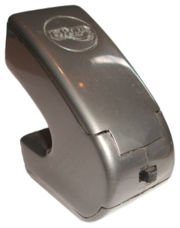
An EBow
The EBow or ebow (brand name or E-bow, for "Electronic bow" or Energy Bow) is a hand-held, battery-powered
electronic device for playing the electric guitar. Instead of having the strings hit by the fingers or a pick, they are moved by
the electromagnetic field created by the device, producing a sound reminiscent of using a bow on the strings.
The E-bow is used to produce a variety of sounds not usually playable on an electric guitar. By varying the E-bow's linear position
on the string, the player can produce different string overtones, and also fade in and out by lowering and raising the E-Bow.
An early pioneer of E-bow playing was Bill Nelson, who introduced it to Stuart Adamson of The Skids. Adamson went on to use it
heavily with Big Country, and it formed an integral part of their infamous "bagpipe sound". Blondie, Tom Petty and Blue Oyster Cult
were also early users. Guitarist Jimmy Page used an E-bow in the songs "In the Evening" and "Carouselambra" on the Led Zeppelin 1979
album In Through the Out Door, to create a "droning" effect. The E-bow has also been a familiar element in the sound palette
of guitarist Phil Keaggy since the early 1980s. Bela Fleck has used one on an acoustic banjo in concert, also creating a bagpipe like
sound. Australian band The Church featured an E-bow solo in their 1988 hit single "Under the Milky Way." The sound of the 90's band
the Cocteau Twins was largely derived via the Ebow and a host of effects pedals.
While the E-bow is not normally used with the electric bass guitar, which has heavier strings, Michael Manring (who uses light bass
strings) has persevered, and it features heavily on his 1995 album Thonk. He has even been known to use two at once. Steve
Willett of Strange Boutique helped pioneer the use of bass E-bow in the 80s post-punk goth scene. Sigur Ros bassist Georg Holm plays
with one on the untitled sixth track of their 2002 album, ( ) (this song is alternately known as "E-bow"). Rachel's has also used
bowed bass.
Robert Fripp has often been asked if he used an E-bow on record: he never has, relying instead on feedback from speakers, and
(more recently) a Fernandes Sustainer.
The E-bow is mentioned in (the title of) R.E.M.'s "E-Bow the Letter". It is also used in the song.
The alternative-rock band Smashing Pumpkins have also made extensive use of the effect, most notably on the interlude "Sinfony,"
which consists entirely of E-bow. Guitarist James Iha also added E-bow to several songs on Siamese Dream and Mellon Collie and the
Infinite Sadness.
The band Opeth have used the E-bow on many of their albums, such as on the songs Bleak and The Drapery Falls on the album Blackwater
Park. This album was produced by Steven Wilson, whose band Porcupine Tree also uses it heavily on their albums, such as In Absentia
and Deadwing.
Solo artist Minuti Inertia of Portland, OR has used the E-bow on many stringed instruments to date: both electric and acoustic guitars,
as well as fretless bass, and electric bass, often combined with keyboards and vocoder, creating an odd yet unsettling sound. The album
"Munchausen Syndrome by President" (2006) features many E-bowed tracks slipping in and out of each other.
The British band James have used the E-bow on several tracks, most notably on the top ten hits Sound and She's A Star.
In the former (when played live), the E-bow actually makes contact with the strings, producing a screeching sound.
The popular British band Coldplay have also used the E-bow on many of their tracks. Guitarist Jonny Buckland's most well known use
of the E-bow can be heard on the track "Spies" and the Live 2003 version of "Amsterdam".
E-Bow and the Acoustic Guitar
Although the E-bow is most commonly played on the electric guitar because of the ease of use and the responsiveness you get from the
pickup, the E-bow has also been used in applications with the acoustic guitar. Notably, this was used by Pink Floyd Guitarist, David
Gilmour, in their 1994 song Take It Back on his Gibson J-200 acoustic.
Generally an acoustic guitar gives you a limited response for varying reasons, including the pickup and both the density and spacing
of the guitar strings. But despite these limitations, using an E-bow on an acoustic guitar gives a rich, flute and clarinet-like tone
with a slow-swelling response.
Acoustic Guitarists Who Use The E-bow
- Phil Keaggy
- Michael Miles, acoustic artist
- Arctica, Ebow-experimentation pioneers
This article is licensed under the GNU Free Document License
It uses material from the Wikipedia article - E-Bow
|
